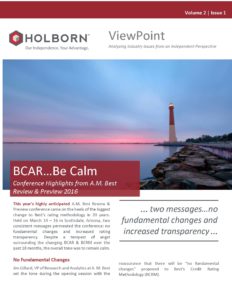This year’s highly anticipated A.M. Best Review & Preview conference came on the heels of the biggest change to Best’s rating methodology in 20 years. Held on March 14 – 16 in Scottsdale, Arizona, two consistent messages permeated the conference: no fundamental changes and increased rating transparency. Despite a tempest of angst surrounding the changing BCAR & BCRM over the past 18 months, the overall tone was to remain calm.
No Fundamental Changes
Jim Gillard, VP of Research and Analytics at A. M. Best set the tone during the opening session with the reassurance that there will be “no fundamental changes” proposed to Best’s Credit Rating Methodology (BCRM).
The new annual review process will remain based on the same quantitative and qualitative risk factors as in the current methodology:
- Balance sheet strength
- Operating performance
- Business profile
- ERM
Increased Transparency
Consistent with private discussions with Holborn, A. M. Best senior executives expressed a strong interest in lifting the curtain on the BCAR calculation, in order to encourage meaningful dialogue with organizations during the Comment Period, currently underway, as well as in the future. This “increased transparency” theme appeared in presentations throughout the conference.
A Better Microscope
Matthew C. Mosher, Executive Vice President & Chief Operating Office, Rating Services at Best, stated he was “confident that the current ratings are appropriate.” Mr. Mosher went on to note that the new model takes advantage of the improvements in technology. Both the new BCRM and BCAR are a “better microscope” that provide more clarity and insight into the risk factors considered in the current model.
In addition, advances in computing power make incorporating stochastic simulation, probability distributions, correlation matrices, and an economic scenario generator more accessible. Just as sophisticated risk managers use these tools within a DFA framework, so too will Best in their own analysis. Within the methodology, Mosher noted he expects to see the most analytical enhancements in the areas of catastrophe losses, group ratings, and assets.
Five Critical VAR Levels
Consistent with the theme, the session hosted by Thomas M. Mount, VP Actuarial Analysis and Capital Modeling at Best, entitled “BCAR Focus 2017: Theoretical and Applied View” described the proposed methodology’s evaluation of capital adequacy at five critical Value at Risk confidence levels, or return times:
95% or 1:20
99% or 1:100
99.5% or 1:200
99.8% or 1:500
99.9% or 1:1000
The new ratio measures “excess or shortfall capital,” the difference between Available Capital and Required Capital, expressed as a percent of Available Capital and has a theoretical maximum value of 100%. A positive value at each evaluation point indicates capital sufficient to endure the demands of these theoretical extreme results. Mr. Mount noted the revised BCRM is not directly linked to any Financial Strength Rating.
The implication of this change will be more information with regards to tail risk than the current approach, which just considers one point. Mr. Mount emphasized that the revised BCAR formula cannot be compared in any way to the current calculation.
Discussion of BCAR, as related to a rating will start by identifying the highest confidence level at which the BCAR remains positive. Again, it is important to note this is only one of several factors used to evaluate Balance Sheet Strength.
Comprehensive Analysis
Assessing Balance Sheet Strength includes a thorough analysis of the following factors, among others:
• Stress Tests
• Quality of Capital
• Liquidity
• Quality & Appropriateness of Reinsurance
Mr. Mount and his colleagues also described enhancements that would provide a broader picture of risks within BCAR, with examples below:
• Bond value risk: introduction of further differentiation by quality and time-to-maturity
• Interest rate fluctuations: stress tests applied based on the new Economic Scenario Generator (ESG)
• Premium adequacy and reserve fluctuations: measured with an industry-based probability distribution, which will first be “Company Adjusted” to reflect expected company-specific performance
Building Blocks
In a presentation entitled “Rating Methodology 2017,” Stephen Irwin, VP at Best, described the “Building Block Approach” that rolls up all of the influences of the main pillars within the BCRM. Upon establishing a baseline Balance Sheet Strength, the analyst team will arrive at an initial Issuer Credit Rating.
From there, positive and negative adjustments, or “notching,” will be applied based on Operating Performance, Business Profile, Enterprise Risk Management, a Comprehensive Adjustment (capturing unique strengths or weaknesses not reflected elsewhere), and finally a Rating Enhancement representing the lift or drag from the group (applicable only to some secondary rated entities).
More Dialogue
In the closing remarks, Stefan Holzberger, A.M. Best’s Chief Rating Officer, encouraged dialogue with A.M. Best during the comment period — which runs now through the end of December 2016. Any feedback related to the BCAR and BCRM from all interested parties will be considered and incorporated as needed with anticipated rollout in the first quarter of 2017.
Holborn’s analytics and account teams are tracking the developments with the rating process, and are available to provide recommendations, assistance and perspective. www.holborn.com
Download here: ViewPoint_BCAR_Vol2Iss1


